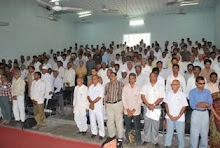Business Standard: New
Delhi: Saturday, March 15, 2014.
When the MCX
Stock Exchange (MCX-SX), now a subject for the Central Bureau of Investigation
(CBI), was conceived, it was as a currency exchange. In its first application
dated July 21, 2008, to the Securities and Exchange Board of India (Sebi), it
wanted to set up a new exchange by the name of ‘MCX Currency Exchange Ltd’ for
dealing only in the ‘currency futures segment’.
Incidentally,
on the same day, K M Abraham, a 1982 batch IAS officer, took charge as a
wholetime member of the regulator. Chairman C B Bhave himself was only five
months old in the job, having taken charge in February that year.
Sebi had a
meeting with MCX on July 29, 2008. A day later, MCX modified the name to
‘Indian Exchange Ltd’. Sebi files show a legal impediment in the Securities Contract
Regulation Act (SCRA) that govern the functioning of an exchange led to this
change. While the Reserve Bank-Sebi technical committee had conceptualised and
approved the contours of exchange-based currency trading in India, the legal
framework for this new concept was not there. While existing stock exchanges
could include this segment as an add-on in their licences, an upstart currency
futures-only exchange was not conceived by law. Thus, Sebi was treading in
uncharted territory. Several issues were raised and discussed, the files
obtained through the Right to Information (RTI) law by Business Standard show.
The current
name of ‘MCX Stock Exchange’ finally came up on August 6, 2008, when the
exchange communicated this through a letter to Sebi. “Since there is no
provision in the SCRA to grant recognition to a ‘currency exchange’ and Sebi
can grant recognition only to a ‘stock exchange’ under section 4 (1) of SCRA,
MCX proposes to seek Sebi approval for recognition as a stock exchange and to
seek permission for starting currency futures segment only in the initial
phase,” the Sebi note put up on August 12, 2008 said.
Two days
after the meeting, Thomas R Fernandes, senior vice-president (legal &
secretarial) of MCX gave an affidavit regarding an income tax raid on the
group’s premises. The affidavit stated, “On June 19, 2007, MCX and FTIL, the
promoter of MCX, were subject to search, seizure and survey operations under
section 132 and 133A of the IT Act… During these operations, certain documents,
computer CDs and records were seized by IT authorities from the MCX premises.”
It added the commodity bourse had given information and clarification the IT
department sought from time to time and it had not received any demand for
additional tax.
In addition,
MCX told Sebi a similar affidavit had been filed with Central Electricity
Regulatory Commission at the time of seeking recognition for Indian Energy
Exchange. The timing of this affidavit, coming two days after the Sebi-MCX
meeting, and that it was not part of the original application suggest Sebi had
checked about the raid during the meeting.
FAST-TRACK
CLEARANCE
· June
19, 2007: Income tax raid on FTIL,MCX Mumbai premises
· August
27, 2007: Sebi grants no-objection certificate to FTIL 5% stake buy in Delhi
Stock Exchange
· September
13, 2007: NoC to Vadodara Stock Exchange Stake buy
· October
17, 2007: Finance ministry letter to Sebi to defer stake purchases by FTIL
group, citing June raids
· February
18, 2008: C B Bhave takes the baton as Sebi chairman from M Damodaran
· June
12, 2008: Finance ministry update on IT raid
· July
21, 2008: FTIL, MCX apply to Sebi for MCX Currency exchange; K M Abraham takes
charge as wholetime member
· July
29, 2008: Sebi-MCX meeting
· July
30, 2008: Group seeks change of name as Indian Exchange Ltd
· July
31, 2008: MCX legal dept gives affidavit on IT raid
· August
6, 2008: MCX Stock Exchange name sought
· August
12, 2008: Sebi legal department gives opinion in favour of considering the
application
· August
13, 2008: NSE gets approval for currency segment
· August
20, 2008: MCX-SX pays recognition fee to Sebi
· August
22, 2008: MCX-SX gives key undertakings; MIMPS issue highlighted in a Sebi note
· September
9, 2008: Sebi onsite inspection
· September
16, 2008: Recognition granted
Source:
Sebi documents obtained through RTI
How did Sebi
come to know about the raid? In the second of three draft prospectuses filed by
MCX for its Initial Public Offer, on February 22, 2008, there was a disclosure
titled ‘tax proceeding’. It said, “On June 19, 2007, the Department of Income
Tax carried out search and seizure operations under Section 132 (1) of the
Income Tax Act, 1961, against us. During these operations, certain documents,
loose papers and computer compact discs and records were seized.”
Elsewhere in
the same prospectus, under ‘Tax proceeding against FTIL’, it said referring to
the same raid, “Based on the findings of these search and survey proceedings,
the department may undertake proceedings which may result in demands for
payment of additional taxes or levy penalties, or take other action against our
promoter.” These were handled by a separate division called division of issues
and listing, under the corporate finance department of Sebi.
However, on October
17, 2007, a good four months before Bhave took charge as Sebi chief, the
finance ministry wrote a letter to Sebi executive director Manas S Ray,
forwarding a ‘self-contained note’ on the search and seizure operations.
Written by M S Sahoo, director (securities markets), it said, “Though above
documents do not provide final findings, these provide adequate basis to
conclude prima facie that Financial Technologies, MCX and Mr Jignesh Shah are
not ‘fit and proper persons’ to acquire shares in stock exchanges... Sebi is
advised to defer any proposal to acquire shares in stock exchanges by these
entities until CBDT issues a showcause notice to them or clears them of any tax
liability.”
Sebi did not
override this ministry letter while giving nod to FTIL’s stake purchases in
Delhi Stock Exchange (DSE) and Vadodara Stock Exchange (VSE). By the time the
letter came, approvals had already been given. Sebi granted its no-objection
for the DSE deal on August 27, 2007, while that for the Gujarat-based exchange
was given September 13, 2007. It is not clear how the ministry wanted to defer
this. The file notes there was an update from the ministry on June 12, 2008. It
is not clear what this update was.
Referring the
matter to Sebi’s legal affairs department (LAD), the file notes, “It may be
pertinent to mention that though FTIL had acquired 5 per cent stake each in DSE
and VSE, MoF (Ministry of Finance) had advised to defer any proposal by these
entities to acquire shares in stock exchanges until CBDT clears them of any tax
liability. Hence, it is submitted for consideration whether these entities may
be permitted to set up a stock exchange under SCRA.”
Division of
Regulatory Action (DRA), the enforcement department under Sebi’s executive
director (legal), gave an opinion in favour of considering the application on
August 12, 2008. The operative part was: “FTIL had earlier sought approval from
Sebi to acquire shares of DSE and VSE. We had taken a considered view that
initiation of an inquiry against FTIL may not itself disqualify it from being
considered ‘fit and proper’, especially when the inquiry outcome is not known.”
Noting the receipt of the finance ministry’s October 2007 letter, DRA said, “In
pending investigation and enquiry cases, Sebi generally grants registration,
subject to outcome of proceedings, in which case final action will be
determined in accordance with law. In the light of this, we may consider the
application of MCX.”
This legal
opinion swung the case in favour of MCX-SX. “The matter has been discussed with
(name removed) and chairman. In view of the same, if approved, no
objection/approval for proposed name as indicated above as per draft letter may
be issued,” a file noting said. Sebi had removed names of officers from the
file to protect their identity.
On August 13,
2008, Sebi communicated its no-objection to the name of MCX Stock exchange and
asked it apply for recognition. Things moved quickly after this and
comprehensive notes were put up on August 22, following the application for recognition.
It is in this note that the controversial MIMPS (Manner of Increasing and
Maintaining Public Shareholding in Stock Exchanges) regulations first come up.
This note said MCX-SX had said it would comply with the provisions of MIMPS
within a maximum period of three years from the date of recognition. After a
final spot inspection by Sebi officials from different departments in
September, a 60-point approval note was prepared for final approval on
September 12, 2008.
The note
zeroed in on 11 key points for decision. Though the IT raid and the legal
department’s opinion find a mention in the long note, it was not listed as a
key point for a decision. MIMPS was one of the 11, and here a suggestion was
made that “NSE (National Stock Exchange) has been allowed time for a year to
alter its capital structure and conform to MIMPS. We may extend the same
treatment to MCX and advise them that recognition would be conditional on their
conforming to MIMPS within one year of date of recognition.”
On September
16, 2008, MCX-SX received recognition. The comprehensive notes say repeatedly
that if approved, it would be the first recognition in 10 years. The entire
process was completed in less than two months, despite several legal questions.
People familiar
with the developments at that time say that having come from a background in
National Securities Depository Ltd (NSDL), an entity with close ties to NSE,
Bhave was conscious that he should not be seen as favouring rival NSE in any
way. Some former officials said Sebi under Bhave had felt that competition
should be encouraged. “At that time, both MCX and FTIL were established firms
in their fields. There was nothing which would stand legal scrutiny against
them. Ministry observations on IT cases could not be legally given credence as
grounds to find them unfit. It was also felt that if we were to grant them a
licence, we should do it quickly, along with BSE and NSE. Sebi was worried that
in the exchange business, early-bird advantage matters and it would have been
guilty of favouring other parties, were we to delay grant of licence to a new
entrant,” according to one of them.
The FTIL camp
nurses a grievance that the raid itself was engineered by rivals. In an
interview to Business Standard in December 2013, Venkat R Chary, former
chairman of MCX, had said Shah’s “corporate rivals” were unable to digest the
high market share of Shah’s exchanges such as MCX and Indian Energy Exchange.
“What they were unable to achieve in the market, they are trying to do through
these campaigns,” Chary said. Recalling the 2007 raid, he said, “They organised
a raid on MCX. It was unprecedented. They even raided Jignesh’s house. But
nothing came out of that.” He claimed an officer involved in the raid had
confessed to him, “We had to do it because orders came from above”. According
to Chary, all these efforts were aimed at proving Shah was not “fit and proper”
and to remove him from the exchange space.
S S N
Moorthy, then director-general of IT (investigations), Mumbai, who had
conducted the raid, said the documents seized in that operation seven years
earlier were given to the assessment division of the department. He said he had
no idea whether a claim was raised or further details. Abraham declined to
comment. Bhave was not reachable.
Two years
later, the same team at Sebi would take a completely different view on the
fitness and propriety of MCX-SX and its owners. That is a different story
altogether.














































































